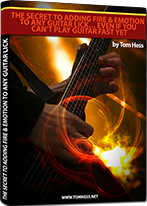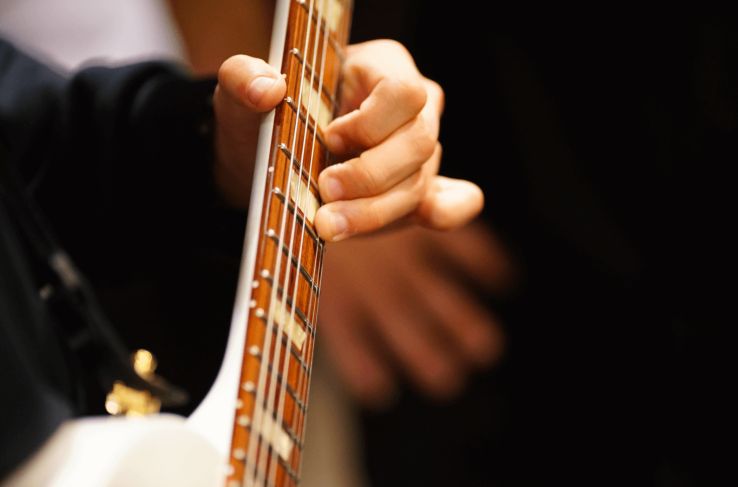How To Put More Emotion Into Your Lead Guitar Licks
by Tom Hess
Emotion To Any Guitar Lick

EMAIL TO GET ACCESS
By submitting your info, you agree to send it to Tom Hess Music Corporation who will process and use it according to their privacy policy.
There is a simple trick that lets you instantly add more feeling and drama to any of your lead guitar licks.
And don't worry...
You don’t require advanced lead guitar playing skills to use it.
You don’t need to know any fancy music theory either.
The trick is called:
Delayed Resolution
And the way it works is:
You build some musical tension with the notes you play...
And then, right in the moment when the listener expects the tension to resolve...
...you delay the resolution.
There are many ways to use this simple lead guitar licks enhancement technique.
Emotion To Any Guitar Lick

EMAIL TO GET ACCESS
By submitting your info, you agree to send it to Tom Hess Music Corporation who will process and use it according to their privacy policy.
Watch the video below to see how delayed resolution works and start using it in your lead guitar licks:
Now that you know what delayed resolution is and how to use it in your guitar licks, what’s next?
The next step is to combine delayed resolution with 3 more must-know elements of great lead guitar playing. These elements injects every one of your lead guitar licks with soul-satisfying emotion.
Emotional Lead Guitar Licks Element #1: Singer-Like Vibrato
If you want your lead guitar playing to sound good – you’ve got to master your vibrato.
What's the secret to good vibrato?
Balance the speed of the vibrato pulses with their width.
This means: the faster your vibrato is, the wider it should be for your lead guitar playing to sound good.
And the slower it is – the more narrow it should be for your guitar playing to sound good. If your vibrato is too slow and wide, it sounds like slow bends – not like vibrato.
Whatever you do – do NOT make your vibrato fast & narrow at the same time. This makes your guitar playing sound nervous.
Watch this video to see & hear what good vibrato should sound like in your lead guitar playing:
Extra tip: For more control over your vibrato, wrap your thumb around the guitar neck.
This helps you keep your guitar playing vibrato in tune and in sync with the tempo of the music. See this photo:

Question: “Tom Hess, what should I do if I try to control my vibrato, but it’s not coming out the way I want?”
Answer: First, listen to the sound of great lead guitar licks that use vibrato. Make a list of players whose vibrato licks you admire.
Then do your best to describe exactly the difference between your vibrato and theirs.
Is it too fast? Too slow? Too wide? Too narrow? Not in tune? Is there string noise?
What precisely as missing? The more specific you can be when describing your problem, the easier it is to come up with a solution.
Second: record your vibrato into your computer and listen back to it at half speed.
This is the most brutally honest test for your overal lead guitar vibrato technique.
Because your mistakes are very clearly heard.
(And you get to hear them away from your guitar. When your mind can best focus on the sounds coming out of your amp.)
 Become An Expressive Songwriter
Become An Expressive SongwriterDisover how to develop accurate self-expression as a songwriter.
 How To Create Emotion On Guitar
How To Create Emotion On GuitarLearn how to accurately express emotions in your guitar playing.
 Improve Guitar Playing Creativity
Improve Guitar Playing CreativityLearn the main reasons why you
struggle to be creative on guitar.
Here are some more advanced vibrato applications:
Chord Vibrato
It’s no secret that many people prefer lead guitar playing over rhythm guitar playing.
But why?
Truth is: most people struggle to be expressive when they use chords in their guitar playing.
This is one reason why lead guitar playing is generally considered “cooler” than rhythm.
But what if you could apply a lead guitar playing technique (vibrato) to chords? Is that even possible?
Yes it is.
Check out this video demonstration to learn how to do vibrato on chords and sound great when you do it. These give you tons of creative guitar playing ideas.
Bent-Тote Vibrato:
Bent note vibrato is much harder than vibrato on an unbent note. But when you get it right… it’s the single most beautiful sound you canuse to enhance your guitar licks.
The biggest challenge about bent-note vibrato? It's keeping the bent note as the target pitch.
Plus, you have 3 key guitar playing decisions to make for bent note vibrato:
1. Raising the pitch above the bent note.
2. Lowering the pitch below the bent note (you need a guitar with a floating bridge for this).
3. Swirl the vibrato above AND below the bent note.
The 3rd type of vibrato is by far the hardest (and in my opinion – the best-sounding).
Watch this video to see what I mean:
Delayed Vibrato
Don’t rush to apply vibrato as soon as you play a note. Instead, let the note ring out for about a second and then add vibrato.
This improves your lead guitar licks in 3 ways:
- Delayed vibrato makes your guitar licks more dramatic by bringing attention to the vibrato when it happens.
- Delaying the vibrato prevents you from rushing, tensing up and making your vibrato too fast/narrow and out of control.
- It’s easier to sync vibrato with the tempo of the music when you delay it. (That’s because you have a split second to time the start of the vibrato when the note is ringing.)
Of course there are times when applying vibrato to a note immediately can also create some great guitar licks.
You will have a much easier time doing this after you learn to do a controlled/delayed vibrato (but not the other way around).
Delayed vibrato sounds particularly dramatic when you apply it to bent notes.
See & hear lots of examples of delayed (bent) note vibrato in this lead guitar licks video:
And no, double stop vibrato is not only for blues (or classic rock) lead guitar playing. You can use these double stop vibrato and bend ideas in all rock-based styles.
Vibrato is one of the most important techniques I teach my students to help them make their own lead guitar licks. I help my students master this technique in Breakthrough Guitar Lessons. (As well as other techniques you need to play with pro-level lead guitar playing skills.)
Emotional Lead Guitar Licks Element #2: Vocal-Style Guitar Licks
You can learn a ton about playing lead guitar licks with emotion by studying… singers.
Here is why:
Singers can’t sing as fast as you can play in your guitar playing. And they are limited in the amount of notes they can sing on a single breath.
That means: they have no choice but to squeeze maximum emotion out of each note they sing.
And here is an opportunity for your lead guitar playing:
Listen to your favorite singers and learn their vocal parts note for note (on your guitar).
More importantly: match the exact nuances of their vocal style in your lead guitar licks.
This not only gives you a ton of new ideas for lead guitar licks, but also gives your phrasing a unique sound you’d never develop from studying other guitar players.
Watch this guitar playing video to see how to mimic vocal phrasing to play lead guitar licks and solos that sing.
Emotional Lead Guitar Licks Element #3: Rubato For Unique Guitar Licks
Delayed resolution & Rubato go together like hand in glove.
What is rubato and how do you use it in your guitar licks?
It’s a musical concept where you stretch time. I'm talking about gradually speeding up or slowing down within certain phrases.
This doesn't mean to “play out of time” by mistake. It means to accelerate or decelerate the notes intentionally to create the rubato sound.
Rather than write about it, check out this video to see & hear how cool it makes your lead guitar licks sound:
Now you know how to put more emotion into your lead guitar licks.
Want me to help you transform the rest of your lead guitar playing skills? I can do that for you in my Breakthrough Guitar Lessons.
Tell me about your musical goals and lead guitar playing challenges. I’ll create a customized lesson plan to get your guitar playing up to the level you want. And I’ll hold your hand every step of the way to nearly guarantee your results.
To take your lead guitar playing to the next level, go to: https://tomhess.net/Guitar
 About Tom Hess: Tom Hess is a guitar teacher, music career mentor and guitar teacher trainer. He teaches rock guitar lessons online to students from all over the world and conducts instructional live guitar training events attended by musicians from over 50 countries.
About Tom Hess: Tom Hess is a guitar teacher, music career mentor and guitar teacher trainer. He teaches rock guitar lessons online to students from all over the world and conducts instructional live guitar training events attended by musicians from over 50 countries.
 | Forward this article to your friends |

